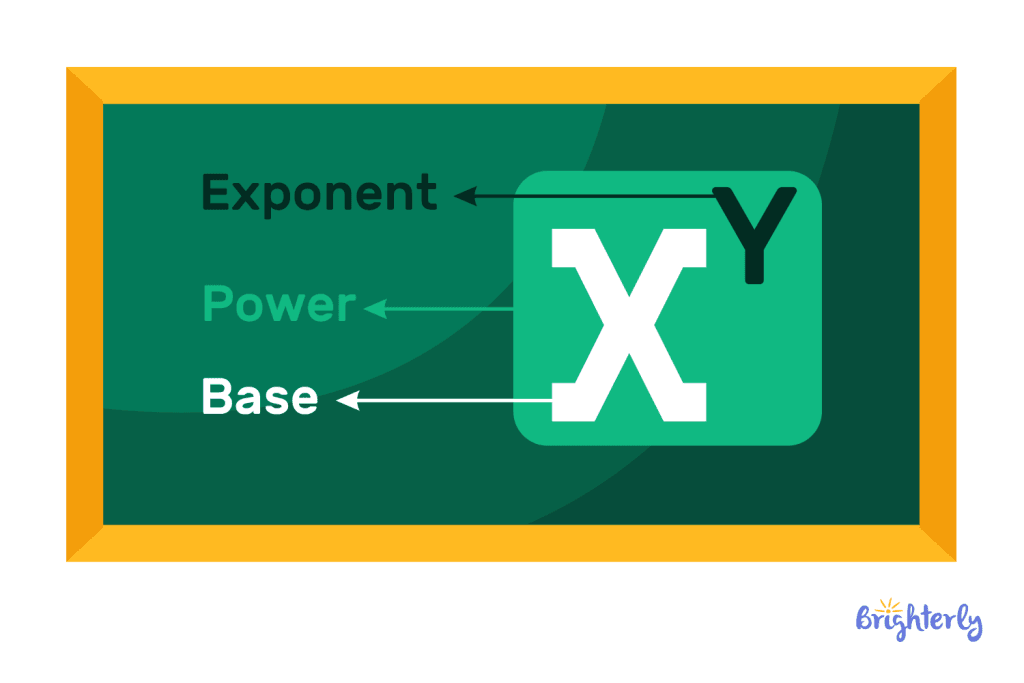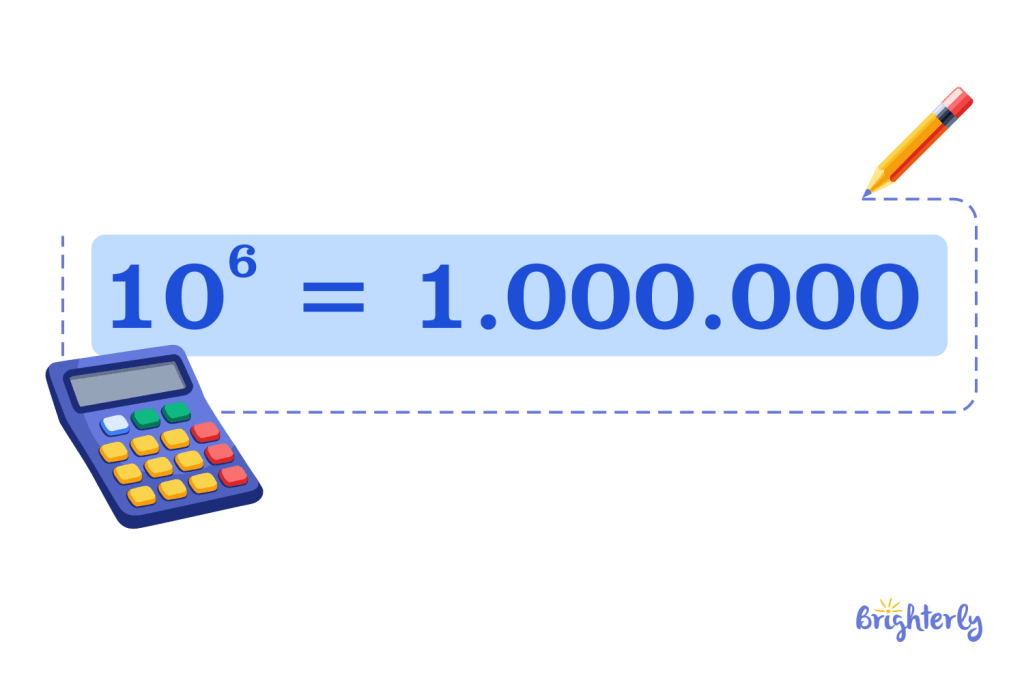Base of an Exponent – Definition with Examples
Updated on December 3, 2025
As well as multiplying numbers, understanding exponents and their bases is necessary for algebra, exponential growth, science, programming, and economics. At Brighterly, we use clear examples and helpful exercises to break down complex concepts into manageable steps. Here is Brighterly’s guide to teach your child how to read numbers like a code and recognize patterns in how they multiply.
What is the base of an exponent?
In simple terms, the base is the number that is repeatedly multiplied in an exponential expression. The exponent tells how many times to multiply that base. For example, in 23, the base is 2 and the exponent is 3, meaning 2 × 2 × 2 = 8. This idea is often called the base definition math exponent — the base is the starting number that forms the pattern of repeated multiplication.
Take a look at an expression using a base and an exponent: xy

So, in the power xy, the letter “x” is the base. The letter y is the exponent. It means that a is multiplied by itself n times.
We can read it in different ways:
- x to the power of y
- x raised to y
- x to the y
- x to the yth power
For example: 24
Here, 2 is the base, and 4 is the exponent. Example of base in math:
2 × 2 × 2 × 2 = 16
So, the base tells us which number is repeated, and the exponent tells us how many times.
Visual suggestion: Add a simple diagram showing 2 × 2 × 2 × 2 with boxes or circles, labeling the base and exponent.
Definition of base in math
Exponent bases are derived from multiplying numbers repeatedly. Exponent bases are important when:
- Expanding numbers of 10 (populations, savings, bacteria colonies)
- Decaying numbers of 10 (radioactive decay, cooling rates)
- Powers of 10 in large numbers (1 million is 106)

Every exponential expression is built from its base — without it, the expression cannot be computed.
Properties of the base of an exponent
Examining the following rules makes it simpler to comprehend the base exponent:
- Negative Exponent: Multiply the reciprocal of the base by its reciprocal.
- Positive Exponent: Multiply the base by the exponent’s indicated number of times.
- Roots are indicated by fractional exponents, such as 41/2= √4 = 2.
- Zero Exponent: One is equal to any non-zero base to the power of 0.
Examples of the base of an exponent
Let’s see a couple base and exponent examples. In this expression, four is multiplied by itself three times 43 (4 × 4 × 4 = 64). “7” is the base in the expression “72,” which indicates that 7 is being multiplied by itself twice (7 × 7 = 49). “-2” is the base in a negative base expression, such as -23, meaning that -2 is multiplied by itself three times (-2 × -2 × -2 = -8).
Difference between base and exponent
A base of exponent represents the number we keep multiplying and an exponent represents the number we multiply by itself. Together, they give us the full value of the expression. For example, in 3 to the power of 4, 3 is the base and 4 is the exponent, which means 3 × 3 × 3 × 3 = 81.
Importance of the exponent and base
Using the base of an exponential function, we can determine how quickly things increase or decrease. The base controls how patterns change over time. To understand how to find the base of an exponential function, look at the number that is being raised to a power. For example, in y = 2x, the base is 2. When x increases by one, y doubles — this is called exponential growth. If the base is smaller than 1, as in y = (½)ˣ, the value of y gets smaller each time, showing exponential decay. The concept of the base appears in many real-life situations, such as population growth, interest on money, and gradual cooling over time.
Understanding the base in different exponents
Bases and positive exponents
The number of times to multiply the base by itself is indicated by a positive exponent. For instance, in 34, the base is 3, and the exponent 4 instructs us to multiply 3 by itself four times (3 × 3 × 3 × 3 = 81).
Bases and negative exponents
When an exponent is negative, as in 2-3, we multiply the base’s reciprocal (in this case, 1/2) by itself three times (1/2) × (1/2) × (1/2) = 1/8). Thus, the base continues to be crucial in deciding the result.
Bases and fractional exponents
Although fractional exponents, such as 41/2, may appear frightening, keep in mind that the base “4” is still the number in question. In this instance, the square root of 4, or 2, is equal to 41/2.
Calculations involving the base of an exponent
Multiplying exponents with the same base
Adding exponents to numbers with the same base is equal to adding them together with the same base. For example, 43 × 42 = 43+2 = 45.
Dividing exponents with the same base
When dividing, keep the base and subtract the exponents of the divisor and dividend. For example, 95 / 92 = 95-2 = 93.
Raising a power to a power
To multiply two numbers with the same base by two exponents, multiply the exponents. For example, (24)^3 = 2^(43) = 212.
Practice problems on the base of an exponent
Below are several base and exponent examples with answers to help students practice identifying bases and solving exponential expressions step by step.
1. Simplify and identify the base:
34
Hint: Multiply the base of exponent 3 by itself 4 times.
2. Find the value of the expression and its base:
-23
Hint: Remember that multiplying a negative number by an odd number of times keeps it negative.
3. Simplify the expression with a fractional exponent:
161/2
Hint: A fractional exponent like 1/2 represents the square root of the base.
4. For a negative exponent, calculate and identify the base:
5-2
Hint: An exponent with a negative value will be indicated by multiplying the reciprocal of the exponent and base.
Conclusion
An exponential expression begins with the base, the number that determines the pace of growth or decline. Exponents and bases are explained with examples and answers to show how even small changes can completely change a pattern. The exponent perspective allows us to see how changes unfold across a broad spectrum, such as finance or science, rather than simply as a set of numbers.
Frequently Asked Questions on the Base of an Exponent
What is the base of an exponent?
If the exponent is 4, the base of 2 increases, since the exponent is multiplied repeatedly.
What is an example of a base in math?
In the expression 53, 5 is the base. Multiplying 5 by itself three times gives 125. Negative bases are also possible, e.g., -32 = 9.
How do bases and exponents work together?
The base is multiplied by the exponent as many times as indicated by the exponent, such as 2 × 2 × 2 × 2 × 2 = 32.
What is the prime example of base and exponent?
There is only one way to express a large number, such as 1,000,000, which is by multiplying the base by 6. Here, 10 is the base, and 6 is the exponent.






